
AI tools are transforming data analysis for enterprises, offering faster processes, better integration, and compliance with strict regulations. This article evaluates six top platforms - Prompts.ai, StackAI, DataRobot, Splunk, Tableau, and Power BI - based on their scalability, governance, integration, and cost efficiency. Here's a quick highlight:
Each tool is tailored to specific enterprise needs, from cost management to advanced analytics. Below, explore how these platforms compare and which might fit your organization best.
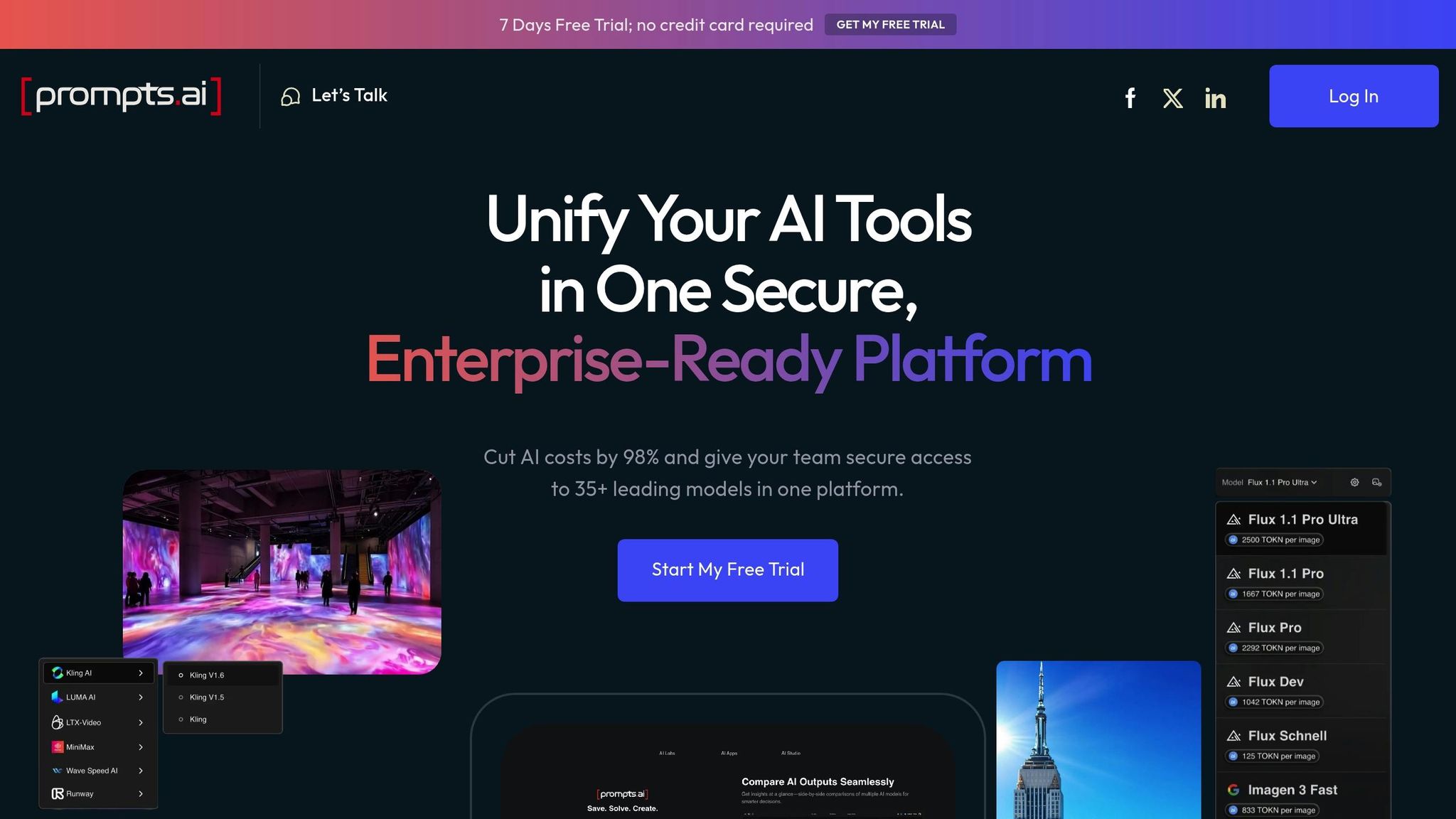
Prompts.ai steps up to tackle the challenges of enterprise AI workflows by offering a streamlined and unified solution. By integrating over 35 leading language models - such as GPT-4, Claude, LLaMA, and Gemini - into a single interface, it eliminates the complexity of managing multiple tools.
Prompts.ai introduces a Pay-As-You-Go TOKN credit system, which aligns costs with actual usage instead of fixed subscriptions. This approach makes budgeting simpler for finance teams and enables businesses to expand their AI operations without worrying about rigid monthly fees.
The platform enhances workflows with pre-built prompt workflows, known as "Time Savers", designed for business analysts. Meanwhile, data scientists benefit from advanced customization options and a dedicated Prompt Engineer Certification program. By fostering internal expertise, Prompts.ai reduces reliance on external consultants, creating a more self-sufficient workforce. These features are further reinforced by robust security and compliance measures.
Prompts.ai embeds security and compliance into every layer of its operations, helping organizations meet EU AI Act requirements with ease. Its proactive approach ensures businesses stay ahead of evolving regulations.
Key features include real-time monitoring to detect and address risks swiftly, plus data privacy controls that automatically redact sensitive information, sanitize data in real time, and provide precise access controls. These safeguards enable enterprises to harness AI effectively while maintaining strict governance over their data.
The platform also includes content moderation tools that monitor and filter AI-generated outputs in real time. This ensures all content aligns with organizational policies and prevents harmful or inappropriate outcomes.
"Through its robust security and compliance capabilities, Prompt Security helps enterprises navigate the EU AI Act's requirements while maintaining efficient and effective AI operations." - Prompt Security Team
Prompts.ai simplifies integration by offering a single connection point for all supported models, reducing the technical burden of managing multiple systems.
Its policy management and enforcement tools allow organizations to create department-specific policies, implement role-based access controls, and monitor adherence to AI usage guidelines. This ensures that different teams have access to the right AI resources while maintaining overall governance.
Hidden expenses are addressed with Prompts.ai's built-in FinOps layer, which tracks token consumption across all models and applications. This visibility helps enterprises link AI expenses to business outcomes and uncover areas for optimization.
The platform’s usage-based pricing model, combined with real-time cost monitoring, helps businesses make informed decisions about selecting models based on both performance and cost. This transparency ensures enterprises can scale their AI operations without any financial surprises.
Prompts.ai’s scalable architecture allows businesses to quickly add models, users, and teams, enabling them to adapt to changing needs with ease. This flexibility is vital for scaling AI capabilities across multiple departments.
Additionally, the platform provides comprehensive audit trails that document every AI interaction, ensuring transparency. Its ability to adjust compliance measures to meet evolving regulations further protects AI investments, giving enterprises the confidence to grow their operations securely and efficiently.
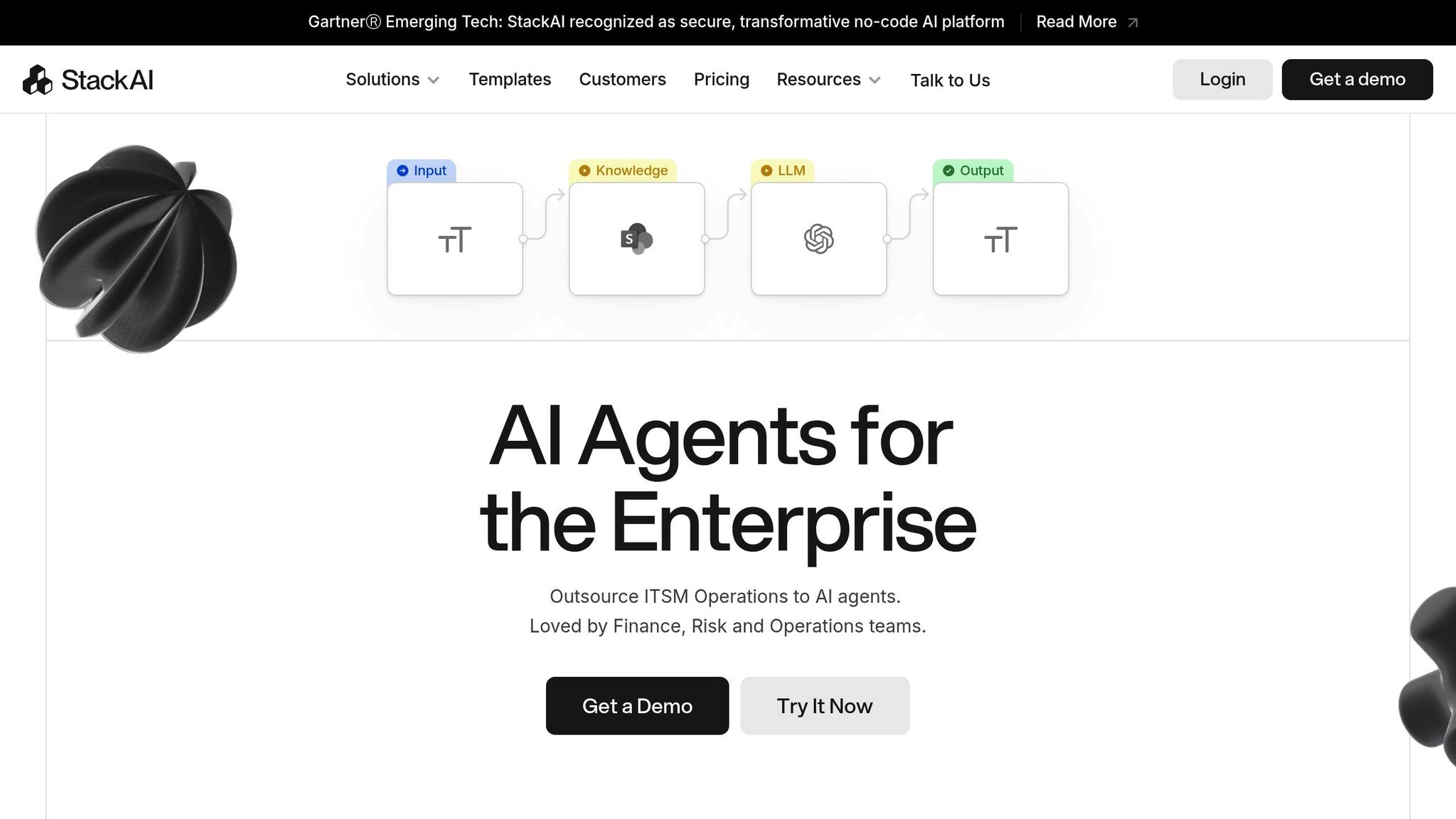
StackAI stands out as a no-code AI platform, designed to empower enterprise teams to create and deploy AI workflows without needing deep technical expertise. With its focus on simplifying AI development, the platform enables business users to build data analysis applications using intuitive visual interfaces and drag-and-drop tools.
StackAI is tailored for enterprises, prioritizing workflow automation and team collaboration. It offers a range of pre-built templates for tasks like customer segmentation, financial forecasting, and operational reporting. These templates are fully customizable, allowing businesses to adapt them to their specific needs - all without writing a single line of code.
The platform supports multi-user environments with role-based permissions, ensuring secure collaboration across teams. Users can share workflows, datasets, and insights via centralized dashboards that provide real-time updates on ongoing projects. Its version control system adds an extra layer of organization by tracking changes to workflows and models, making it easy to revert to earlier versions - a critical feature in environments where multiple contributors are involved and accountability is key.
StackAI takes security seriously, implementing data encryption both in transit and at rest. The platform meets SOC 2 Type II standards and includes audit logs to track user activity and data access.
With its data governance tools, organizations can enforce policies around data usage, model deployment, and sharing outputs. Administrators can control dataset access based on user roles and ensure compliance with internal policies. Additionally, the platform offers privacy controls, such as automatic data masking, which identifies and safeguards sensitive information like personally identifiable information (PII) and financial data during analysis.
StackAI integrates seamlessly with over 200 data sources, including widely-used enterprise tools like Salesforce, HubSpot, and Google Analytics, as well as various database platforms. Its API-first design ensures smooth integration with existing enterprise systems.
The platform also supports real-time data synchronization, keeping workflows and dashboards up-to-date with the latest information. For companies with unique integration needs, StackAI offers custom connector development, where its technical team collaborates with businesses to create specialized connectors for proprietary or niche systems.
Built on a cloud-native architecture, StackAI automatically scales computing resources during peak usage to maintain performance. It efficiently handles large datasets, leveraging distributed computing to process millions of records. Some enterprise users have successfully deployed workflows managing datasets over 100GB in size.
The platform also supports multi-environment setups, allowing organizations to maintain separate development, testing, and production environments. This setup ensures experimental workflows don’t disrupt live operations and enables thorough testing before deployment.
With its comprehensive features and enterprise focus, StackAI is a strong contender in the AI solutions market, offering the tools businesses need to streamline operations and unlock the power of their data.
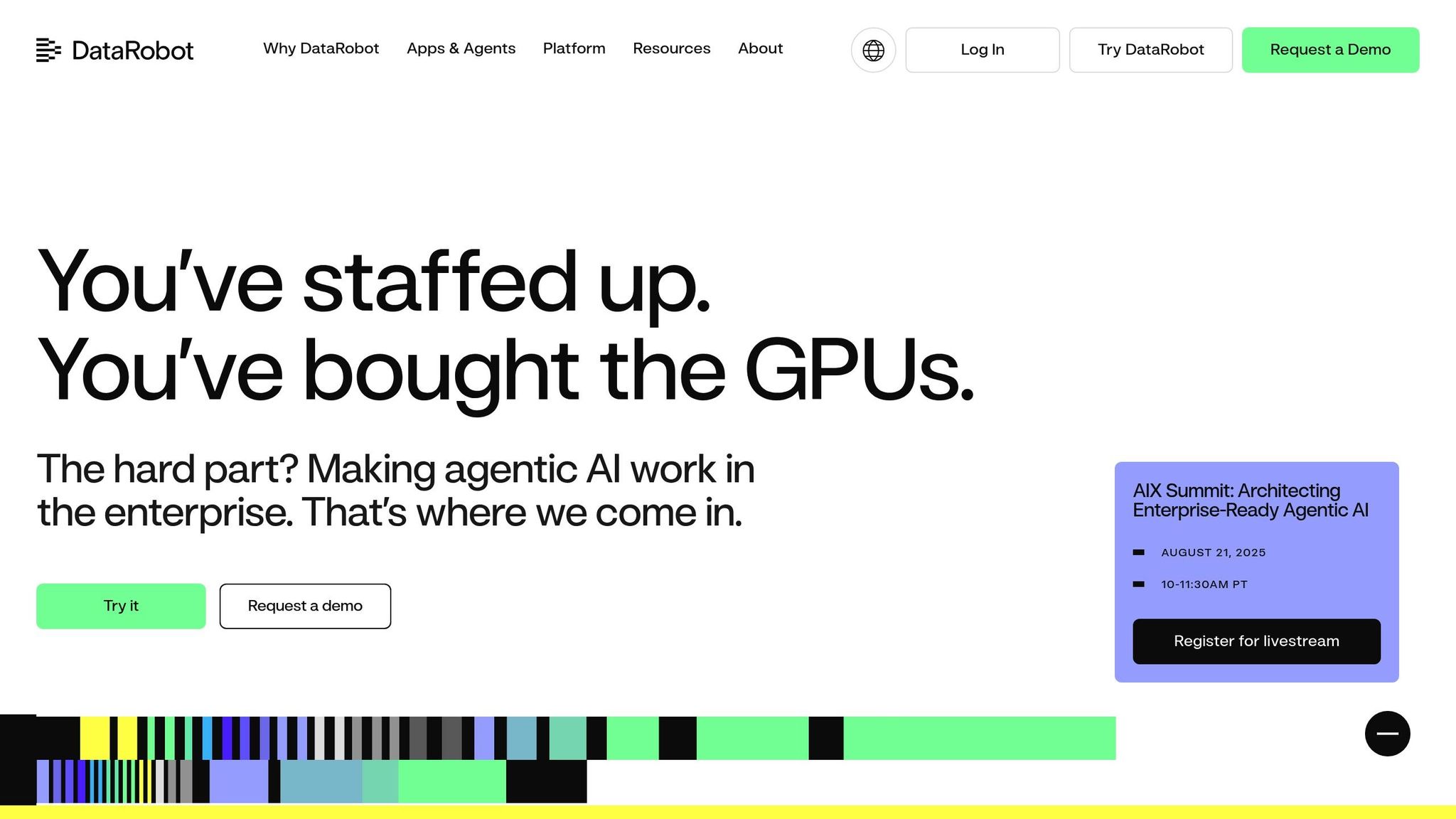
DataRobot simplifies the machine learning process by automating tasks across the entire lifecycle, from preparing data to deploying models. This AutoML-driven platform bridges the gap between business users and data scientists, offering tools that cater to both straightforward analytics and complex enterprise requirements.
DataRobot streamlines enterprise workflows by testing and ranking hundreds of algorithms in a fraction of the time it would take manually. This efficiency, combined with detailed model explanations, transforms weeks of effort into just a few hours - meeting the high demands for speed and accuracy in large-scale operations.
With MLOps capabilities, DataRobot supports version control, A/B testing, and automated retraining of models. A centralized dashboard gives data science leaders a clear view of all active models within the organization, ensuring consistent governance and performance monitoring.
The platform also empowers non-technical users by enabling natural language queries. For example, users can ask questions like "What drives customer churn?" and receive visual, easily digestible insights. This user-friendly approach ensures that even those without technical expertise can leverage data-driven insights effectively.
DataRobot prioritizes security with SOC 2 Type II certification and offers private cloud deployment options for organizations with strict data residency requirements. Its built-in audit trails track every action taken on models and datasets, which is particularly valuable for industries like healthcare and finance that operate under tight regulatory scrutiny.
Every prediction made by the platform comes with model explainability, offering clear, transparent reasoning behind automated decisions. This level of accountability is especially critical for sensitive applications, such as credit assessments, hiring processes, and medical diagnostics, where regulatory compliance is non-negotiable.
DataRobot integrates effortlessly with leading enterprise data platforms such as Snowflake, Databricks, and Amazon Redshift, enabling seamless data flow. It supports both batch processing and real-time scoring, allowing businesses to make predictions on live streaming data or large datasets processed overnight.
For organizations with unique infrastructure needs, DataRobot offers REST APIs and compatibility with Docker and Kubernetes, making it easy to integrate into existing systems and deploy containerized solutions.
Built with a cloud-native architecture, DataRobot dynamically adjusts computing resources and model deployments to match demand. Whether working with datasets containing thousands or billions of rows, the platform uses distributed computing to maintain consistent performance.
DataRobot also supports multi-cloud deployments, enabling businesses to run models across AWS, Microsoft Azure, and Google Cloud Platform simultaneously. This approach not only prevents vendor lock-in but also optimizes costs and performance across regions. Enterprises can deliver real-time predictions with reliable response times while keeping infrastructure expenses under control.
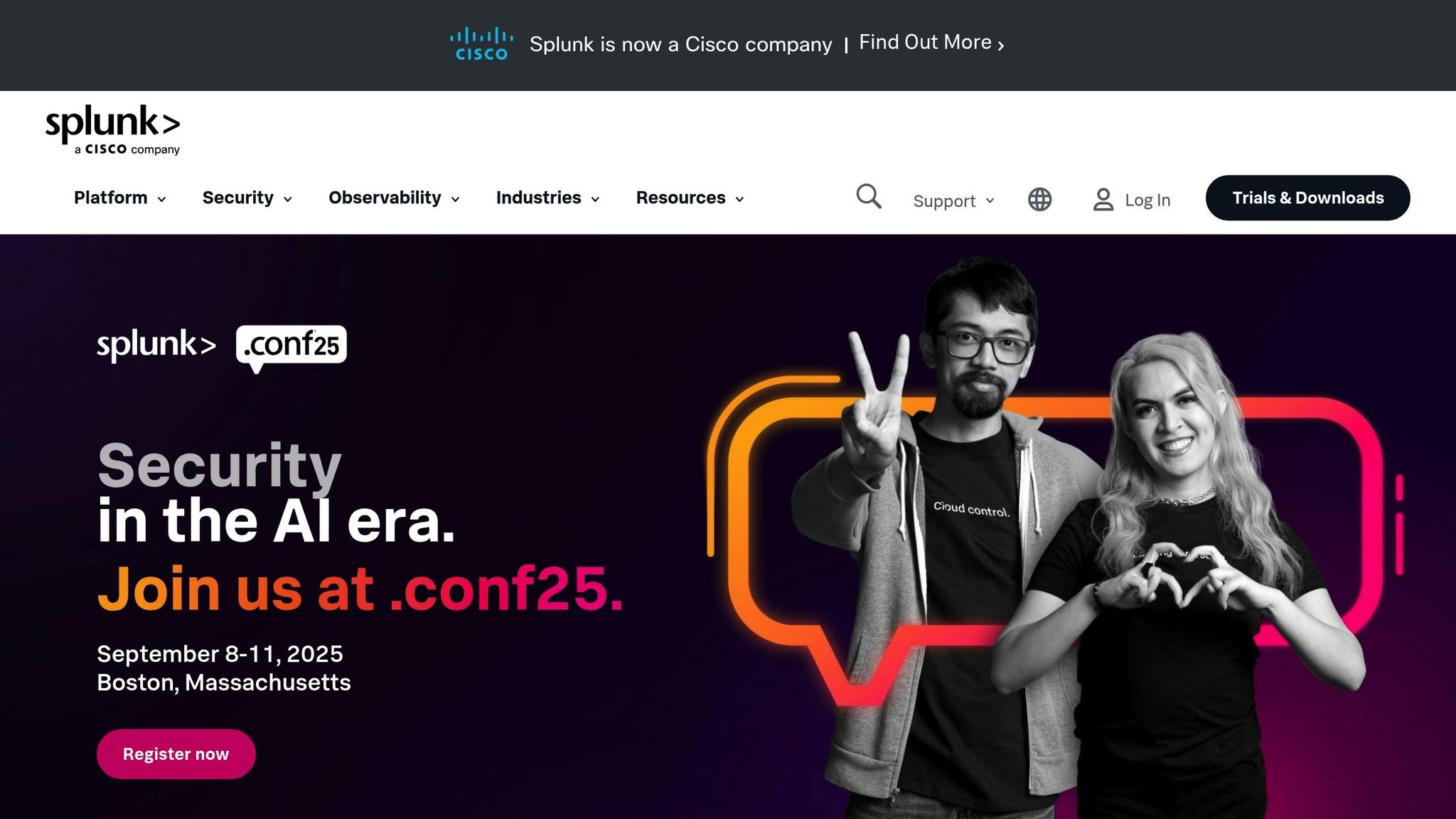
Splunk has evolved from its origins in IT operations to become a powerhouse for transforming unstructured machine data into actionable insights. By leveraging its robust search, monitoring, and analysis tools, the platform helps enterprises extract meaning from complex datasets, including logs, metrics, and streaming data.
Splunk is built to handle massive volumes of data, processing terabytes daily in real-time. Its Search Processing Language (SPL) simplifies querying by using natural language-like commands, making it easier for analysts to dive into complex datasets and derive insights quickly.
With its Machine Learning Toolkit, Splunk integrates predictive analytics into operational data. This allows businesses to forecast potential system failures, identify anomalies, and fine-tune performance - all before disruptions occur. Unlike traditional tools that require extensive data preparation, Splunk works directly with raw data, eliminating the need for time-consuming ETL processes and enabling immediate analysis.
The platform’s Enterprise Security module enhances threat detection by correlating security events across an organization’s infrastructure. This capability is indispensable for large enterprises managing intricate security environments, where manual event correlation is impractical. Combined with its strong security features, Splunk provides the reliability enterprises demand.
Splunk meets stringent security requirements with FedRAMP authorization and supports deployment in air-gapped environments, making it a trusted choice for government agencies and highly regulated industries. Its role-based access controls ensure sensitive data remains secure, even in collaborative environments.
The platform’s audit logging feature meticulously tracks searches, dashboard accesses, and data modifications, creating detailed records to meet regulatory needs. For industries like healthcare, finance, and government, this functionality is crucial during compliance audits.
Additionally, Splunk offers data anonymization tools that allow organizations to share insights across departments without exposing personally identifiable information. This ensures adherence to privacy regulations like GDPR and CCPA while maintaining operational transparency.
Splunk integrates seamlessly with existing enterprise systems through Universal Forwarders, which collect data from nearly any source, such as databases, applications, network devices, and cloud services. With over 2,000 pre-built integrations, the platform reduces the need for custom development, accelerating deployment.
For hybrid and multi-cloud environments, Splunk Connect simplifies the ingestion of logs, metrics, and events from major cloud platforms, ensuring unified visibility across diverse technology stacks. Developers can also tap into Splunk’s capabilities using its REST API and SDKs for Python, JavaScript, and other languages, embedding analytics directly into custom workflows and applications.
Splunk’s architecture is designed for scalability, ensuring it can handle data volumes ranging from gigabytes to petabytes per day. Its indexer clustering feature distributes data processing and storage across multiple servers, maintaining consistent performance as data demands grow.
For organizations leveraging the cloud, Splunk Cloud offers elastic scaling that adjusts compute and storage resources automatically based on data ingestion and search activity. This removes the need for manual capacity planning while keeping performance steady during peak periods.
Finally, the platform’s federated search functionality enables enterprises to query data across multiple Splunk deployments simultaneously. This is particularly valuable for global organizations, allowing them to maintain distributed infrastructure while preserving a unified approach to analytics.
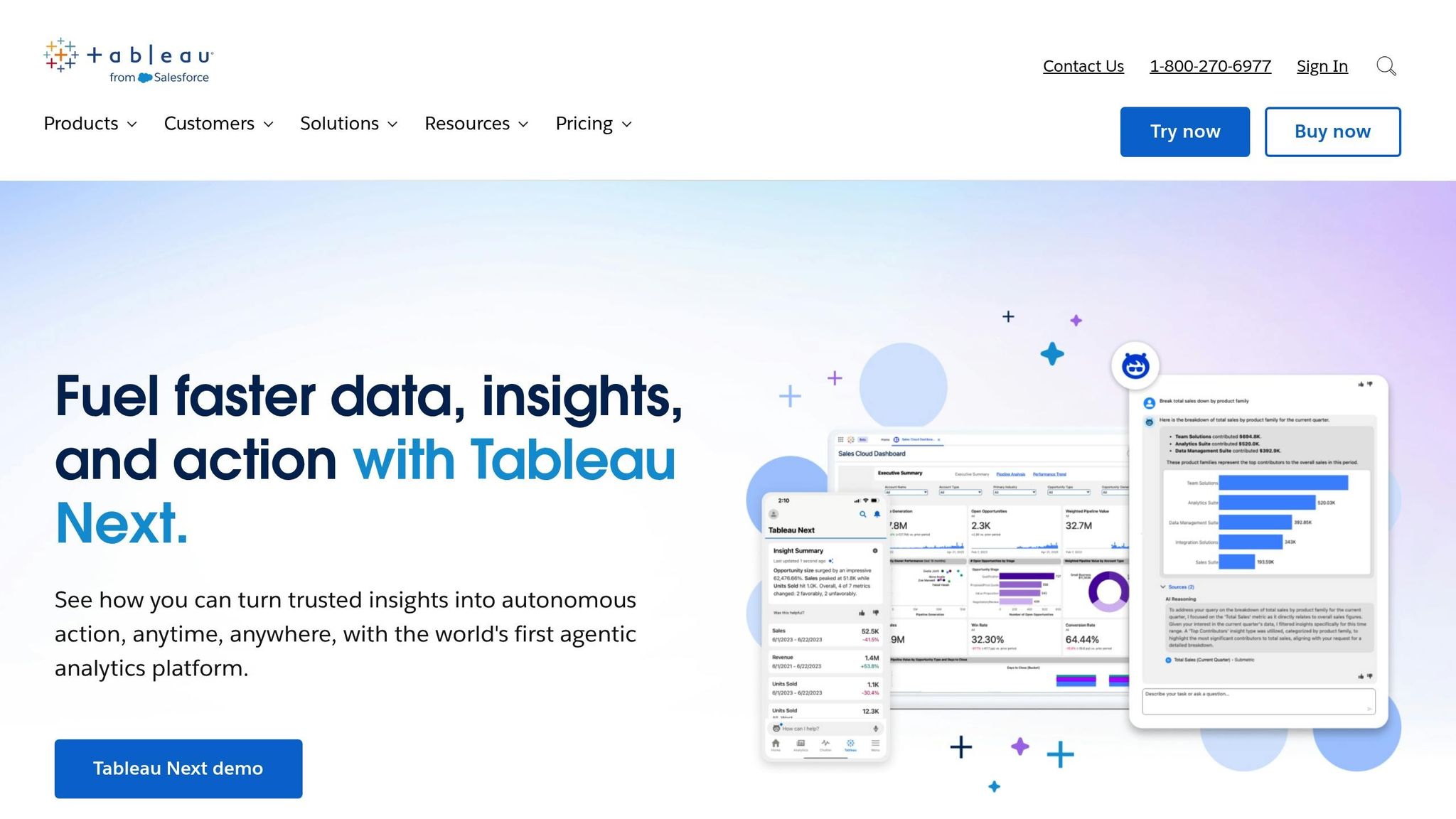
Tableau turns complex enterprise data into visually engaging stories, making it a standout tool for business intelligence and data analysis. Its intuitive drag-and-drop interface opens the door for both technical experts and non-technical users to explore data and uncover insights that drive informed decisions across organizations.
Powered by the Hyper engine, Tableau processes billions of rows in mere seconds, working seamlessly with both traditional databases and modern cloud platforms like Snowflake and Amazon Redshift. This efficiency requires minimal data preparation, making it accessible for a wide range of users.
The Ask Data feature simplifies data queries with natural language processing. Instead of crafting intricate SQL queries, users can type straightforward questions like, “Show me last quarter’s sales trends by region,” and receive instant, clear visualizations. This lowers the technical barrier for business users who need quick answers without diving into complex coding.
Tableau’s Data Management suite enhances organization by cataloging and tracking data lineage. It automatically documents relationships, transformations, and dependencies within datasets, providing a transparent audit trail. This ensures data quality and builds trust across teams.
For collaborative environments, Tableau Server and Tableau Cloud offer centralized governance with role-based permissions. Administrators can restrict access to sensitive data while empowering teams with self-service analytics. This balance of security and accessibility ensures enterprises can maintain control without stifling productivity.
Tableau aligns with SOC 2 Type II standards and supports SAML-based single sign-on, integrating with systems like Active Directory for secure and seamless authentication.
The platform’s row-level security feature tailors data access based on user roles. For instance, regional sales managers see only their territory’s data, while executives can view company-wide metrics - all from the same dashboard.
To safeguard data, Tableau employs encryption both in transit and at rest, with the option for customer-managed encryption keys. Detailed audit logs track user activities, data access, and content changes, helping organizations meet compliance standards like SOX and GDPR.
Tableau connects to over 75 native data sources, from traditional databases like Oracle and SQL Server to modern cloud platforms. Its Web Data Connector framework allows developers to create custom integrations for proprietary systems, ensuring no data source is overlooked.
The REST API adds flexibility, enabling organizations to automate tasks like dashboard publishing, user management, and data refresh schedules. This makes Tableau easy to integrate into existing workflows and enterprise systems.
With Tableau Prep, data preparation becomes a visual and straightforward process. Users can merge datasets, clean missing values, and create calculated fields without needing to write code. Cleaned datasets can then be published directly to Tableau Server, making them accessible across the organization.
Tableau’s architecture is built for growth, using multi-node clustering to distribute workloads across multiple servers. This horizontal scaling ensures that the platform can handle increasing numbers of users and larger datasets. Requests are load-balanced automatically, and compute resources can be scaled independently of storage.
Extract optimization creates compressed, columnar extracts that enable faster queries and incremental data refreshes. Even with datasets containing hundreds of millions of rows, Tableau maintains interactive performance.
For cloud deployments, Tableau Cloud offers elastic scaling, automatically adjusting capacity to match usage patterns. This ensures smooth performance during high-traffic periods, like month-end reporting or critical board presentations, without requiring manual adjustments or risking slowdowns.
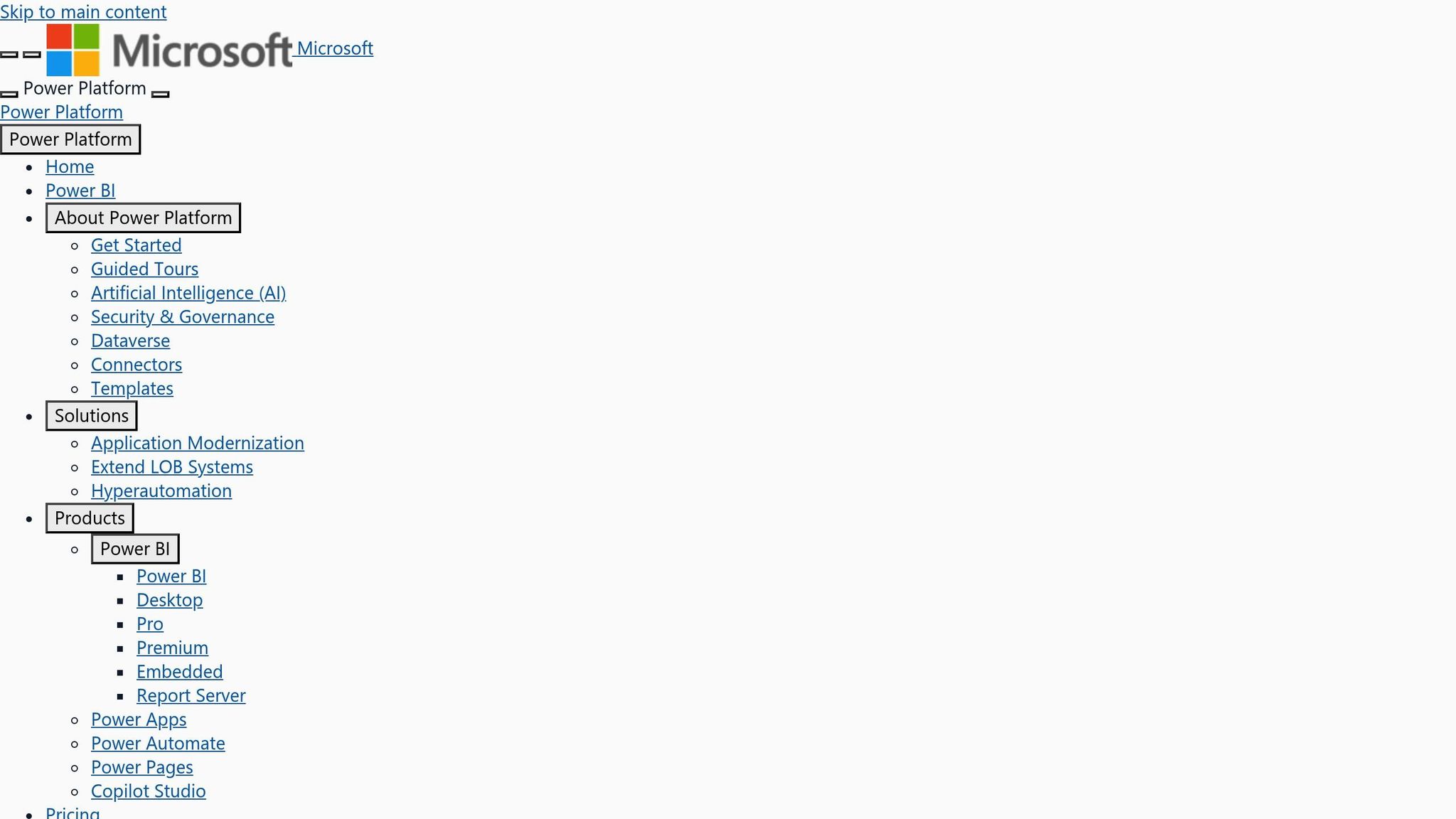
Power BI emerges as Microsoft's powerful tool for enterprise-level data analysis, blending user-friendly Office-style interfaces with advanced AI capabilities. It offers organizations a way to perform sophisticated data analysis while ensuring top-tier security and performance.
Power BI caters to enterprise needs with flexible licensing options and centralized data preparation through dataflows, which allow reusable business logic across multiple reports. For organizations with strict data residency requirements, the Power BI Report Server enables on-premises deployments, keeping sensitive data local while still supporting cloud collaboration.
The platform’s incremental refresh feature enhances efficiency by processing only updated data, cutting down the time needed for real-time reporting. Additionally, composite models combine cached data with live queries, ensuring reports stay up-to-date without compromising performance.
Built on Microsoft’s robust security framework, Power BI integrates seamlessly with Azure Active Directory, enabling single sign-on and multi-factor authentication. It meets industry-standard compliance requirements and includes row-level security, which restricts data access based on user roles - ideal for managing large organizations. Furthermore, Microsoft’s information protection tools help classify and secure sensitive data, while detailed audit logs provide centralized monitoring of user activities.
Power BI natively connects to a broad array of data sources, including Microsoft tools like Excel, SharePoint, and Dynamics 365. Its Power Query engine simplifies complex data transformations with an intuitive visual interface. The Power BI REST API allows for programmatic management of workspaces, datasets, and reports, making automation straightforward.
Integration with Power Automate adds another layer of efficiency by enabling automated workflows triggered by Power BI events. The connection with Azure Analysis Services enhances semantic modeling, ensuring consistent metrics across multiple reports. Together, these integrations streamline processes, manage costs effectively, and support effortless scalability.
Power BI offers flexible pricing models to suit various enterprise requirements. Subscription plans provide predictable costs, covering advanced analytics, scalable data handling, and dynamic content sharing. For customer-facing analytics, Power BI Embedded uses a usage-based pricing model, adjusting for varying user demands.
Administrators can monitor resource usage with capacity insights, optimizing performance and ensuring cost efficiency. Additionally, integration with Azure Cost Management allows for unified expense tracking, with notifications for spending thresholds to prevent budget overruns.
Designed for large-scale operations, Power BI Premium supports massive datasets and allows compute resources to scale independently of storage needs. Auto-scaling ensures consistent performance during peak usage by automatically adding capacity when required.
Advanced storage formats compress data effectively, lowering storage costs while maintaining query speed. The Premium Per User model provides dedicated resources that expand as organizations grow. Multi-geo deployment options also let organizations store data in specific regions, reducing latency and ensuring compliance with local data residency regulations.
When assessing AI tools for enterprise data analysis, it's essential to consider factors like readiness for large-scale use, clear cost structures, ease of integration, and the ability to grow alongside business needs. These aspects directly tie into the earlier discussion of key evaluation points for enterprise solutions. Below is a streamlined comparison of the standout features and any reported drawbacks for the platform.
| Platform | Key Strengths | Reported Weaknesses |
|---|---|---|
| prompts.ai | • Access to over 35 top AI models, including GPT‑4, Claude, LLaMA, and Gemini • Built-in FinOps layer for real-time cost tracking • Flexible pay-as-you-go TOKN credit system with no recurring fees • Advanced security and compliance measures tailored for enterprises • Certification program for prompt engineering, driven by the community |
None reported |
Prompts.ai stands out for its unified model access, transparent cost management, and strong security framework, making it a robust choice for enterprise use. This overview highlights its strengths while noting the absence of reported weaknesses, setting the groundwork for the upcoming recommendations.
Select an AI platform that aligns with your organization's priorities and operational goals. Each tool has its own strengths, catering to diverse enterprise needs. Here's a breakdown to help guide your decision-making:
Organizations operating in regulated industries will find prompts.ai particularly appealing due to its enterprise-grade security framework, clear cost management, and ability to support audit trails and data protection requirements.
Additionally, the technical expertise of your team plays an important role. Platforms like prompts.ai offer robust community support and resources, including the Prompt Engineer Certification, which can simplify adoption and reduce risks during implementation.
To ensure smooth scaling of AI initiatives across departments, prioritize solutions with transparent, usage-based pricing. This approach helps maintain budget predictability while expanding AI capabilities to meet evolving business needs.
Prompts.ai prioritizes adherence to the EU AI Act and comparable regulations by implementing rigorous protocols that emphasize safety, clarity, and ethical AI use. The platform integrates detailed risk evaluations, transparency practices, and protective measures to meet legal standards while safeguarding human rights.
Through its advanced compliance frameworks, Prompts.ai enables businesses to navigate regulatory demands effortlessly, ensuring their AI solutions remain dependable and aligned with legal obligations. This commitment helps enterprise users uphold trust and accountability in their AI-powered initiatives.
A pay-as-you-go pricing model brings several practical benefits for companies leveraging AI tools. With this approach, businesses are charged only for the resources they use, eliminating the need for hefty upfront investments and preventing overspending on services they don’t fully utilize. This setup is especially effective for organizations with workloads that vary or are hard to predict.
Another advantage is its scalability and flexibility, which allows businesses to adjust their usage as their needs evolve. By tying expenses directly to actual usage, companies can maintain better control over their budgets, streamline operational costs, and maximize their overall return on investment (ROI).
Prompts.ai is built to adapt seamlessly to enterprise needs, thanks to its API-first architecture. This design ensures smooth integration with your existing workflows and systems, enabling businesses to expand their AI capabilities without causing disruptions to daily operations.
With advanced language models like GPT-4, Claude, and LLaMA unified into one intuitive platform, Prompts.ai simplifies collaboration and boosts efficiency across teams. Its suite of tools - such as real-time token usage tracking and automated governance - empowers enterprises to manage AI deployments efficiently and keep costs under control. This makes it a powerful choice for organizations focused on large-scale, data-driven decision-making.


